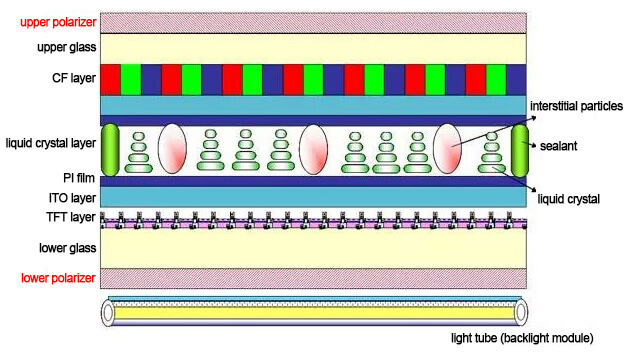LCM, namely LCD Module, is an LCD display device that integrates LCD glass and LCD driver.
It provides the user with a standard LCD display driver interface (different types such as 4-bit, 8-bit, VGA, etc.), and the user operates according to the interface requirements to control the LCD to display correctly.
There are two main types of LCD modules: one is a color LCD module; the other is a black and white screen monochrome LCD module. Among them, the monochromatic LCD module components: monochrome graphic dot matrix LCD display, monochrome character dot matrix LCD display, monochrome segment code LCD display. The color LCD module is mainly a TFT-LCD module, and the STN in the early stage.
LCD module applications are widely used, including but not limited to outdoor mapping PDA handheld devices, medical instruments, IoT warehousing, industrial tablet computers, aerospace navigation instruments, financial payments, drones, robots, smart homes, smart wear, 3D printer, bicycle code table, human-computer interaction, rail transit, mine oil, military security, advertising machine, showcase, game console, vehicle-mounted, camera, power measurement and control terminal, injection molding machine computer, CNC system, biochemical analysis, textile machinery control, Tax control machines, lottery machines, food testing, chromatography, electronic measurement, environmental laboratory equipment, fire safety, automotive electronics, data acquisition, and etc.
The LCD module is simple to say screen + backlight component. The two parts are assembled together, but work independently of each other (ie, the circuit is not relevant). The principle of the LCD display is that the backlight device emits uniform white light, which is transmitted to our eyes through the LCD screen. The function of the screen is to process the light by pixel to display the image.
Take the TFT LCD module as an example:

(1) Polarizing plate: It is mainly used as a grating to allow only light in a single direction to pass, and also to protect the CF layer and the TFT layer.
(2) CF layer and TFT layer: one above the other to form an electric field, and the liquid crystal is arranged under this electric field.
(3) Alignment (PI) film: The alignment film has directional properties that allow liquid crystals to be regularly arranged on the alignment film.
(4) Transparent metal conductive layer (ITO): The upper and lower glass are energized to control the liquid crystal direction.
(5) Frame glue: just like the wall of a house, it is used to block the contact between the liquid crystal and the outside world.
(6) Gap Particles (SPACER): Just like the pillars of a house, it is used to support two substrates.
(7) Liquid crystal: The arrangement of the liquid crystals is controlled under different electric fields to obtain the light quantity of different transmittances, thereby achieving the display principle.
(8) Backlight module: Provide a backlight to present the signal changes of the LCD.
SPI interface: only three SPI signals, one CS and one reset signal are required. The disadvantage is that it cannot be read from the display screen and can only be written. Less used, due to the low frame rate is generally used for low-speed black and white small size monochrome screen, not suitable for displaying video or high-resolution images.
MCU interface: Parallel interface, which will decode commands, timing signal generated by timing generator, and driving COM and SEG drivers. At present, the most commonly used connection mode is generally 80 system, and the data bit transmission has 8 bits, 9 bits, 16 bits and 18 bits. The advantage is that the control is simple and convenient, and no clock and synchronization signals are needed. The disadvantage is that it expends GRAM, so it is difficult to achieve a large screen (QVGA above).
RGB (TTL): The RGB interface is a special parallel interface for displays without a frame buffer. The MCU is responsible for updating the display by providing RGB sub-pixel data (16 bits, 18 bits, 24 bits) and timing signals (HSYNC, VSYNC, DE, CLK). Large screens are used more. Its advantages and disadvantages are exactly the opposite of the MCU mode.
LVDS interface: There are many benefits to TFT displays. It is less susceptible to EMI and crosstalk problems, allowing the transmitter to be placed further away from the display. Similarly, LVDS typically consumes less power, has fewer pins, and has little to worry about signal integrity. LVDS output interface is widely used in 17in and above LCD monitors, such as high-end tablets and notebooks.
MIPI interface: High-speed serial interface (as defined by the alliance), which adopts differential signal transmission, and uses low-amplitude signal swing in high-speed (data transmission) mode, especially for needing to realize differential impedance matching. Mobile platform standard interface, similar to LVDS, but more energy saving;at present, the trend of popularization is obvious. Most of the latest platforms such as TI, nVidia, and Qualcomm are equipped with RGB and MIPI interfaces.1080P is the limit of its capabilities. Often used on smartphones and tablets.
MDDI interface: Mobile Display Digital Interface, proposed by Qualcomm in 2004, can improve the reliability of Mobile phones and reduce the power consumption by reducing the connections, which will replace SPI mode as the high-speed serial Interface in the Mobile field. Used to interconnect the flip top and bottom of the phone.
HDMI interface: High-Definition Multimedia Interface, digital Interface can simultaneously transmit compressed, uncompressed audio signals, video signals, the maximum data transmission speed is 18Gbps, no need to perform digital-to-analog conversion before signal transmission.